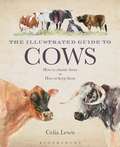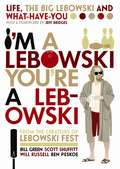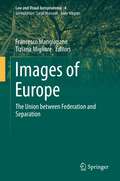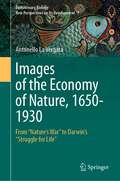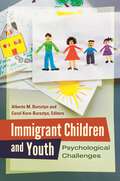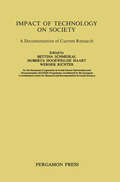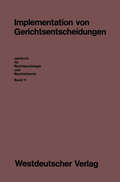- Table View
- List View
The Illustrated Guide to Cows: How To Choose Them - How To Keep Them
by Celia LewisKeeping cattle as a smallholder can be a rewarding enterprise, supplying you with food and milk and helping with the management of grassland on your property. This delightfully illustrated and informative ebook is ideal for anyone interested in keeping a cow or two, who would like to choose the best breed for their circumstances.The Illustrated Guide to Cows covers the 60 most familiar breeds of cattle worldwide. Breed profiles are written in engaging text that covers the history of each breed, its main characteristics and how to look after them, and each one has been beautifully illustrated by the author.Introductory sections contain practical advice on all elements of rearing calves and keeping cattle, including what to consider about land, housing and fencing, whether to choose beef or dairy cows, tips on buying, moving and handling your stock, and guidance on feeding and breeding.
Illustrated Guide to Door Hardware: Design, Specification, Selection
by Scott TobiasYour one-stop, comprehensive guide to commercial doors and door hardware—from the brand you trust Illustrated Guide to Door Hardware: Design, Specification, Selection is the only book of its kind to compile all the relevant information regarding design, specifications, crafting, and reviewing shop drawings for door openings in one easy-to-access place. Content is presented consistently across chapters so professionals can find what they need quickly and reliably, and the book is illustrated with charts, photographs, and architectural details to more easily and meaningfully convey key information. Organized according to industry standards, each chapter focuses on a component of the door opening or door hardware and provides all options available, complete with everything professionals need to know about that component. When designing, specifying, creating, and reviewing shop drawings for door openings, there are many elements to consider: physical items, such as the door, frame, and hanging devices; the opening's function; local codes and standards related to fire, life safety, and accessibility; aesthetics; quality and longevity versus cost; hardware cycle tests; security considerations; and electrified hardware requirements, to name a few. Until now, there hasn't been a single resource for this information. The only resource available that consolidates all the door and hardware standards and guidelines into one comprehensive publication Consistently formatted across chapters and topics for ease of use Packed with drawings and photographs Serves as a valuable study aid for DHI's certification exams If you're a professional tired of referring to numerous product magazines or endless online searches only to find short, out-of-date material, Illustrated Guide to Door Hardware: Design, Specification, Selection gives you everything you need in one convenient, comprehensive resource.
Illustrated Guide to Door Hardware: Design, Specification, Selection
by Scott TobiasYour one-stop, comprehensive guide to commercial doors and door hardware—from the brand you trust Illustrated Guide to Door Hardware: Design, Specification, Selection is the only book of its kind to compile all the relevant information regarding design, specifications, crafting, and reviewing shop drawings for door openings in one easy-to-access place. Content is presented consistently across chapters so professionals can find what they need quickly and reliably, and the book is illustrated with charts, photographs, and architectural details to more easily and meaningfully convey key information. Organized according to industry standards, each chapter focuses on a component of the door opening or door hardware and provides all options available, complete with everything professionals need to know about that component. When designing, specifying, creating, and reviewing shop drawings for door openings, there are many elements to consider: physical items, such as the door, frame, and hanging devices; the opening's function; local codes and standards related to fire, life safety, and accessibility; aesthetics; quality and longevity versus cost; hardware cycle tests; security considerations; and electrified hardware requirements, to name a few. Until now, there hasn't been a single resource for this information. The only resource available that consolidates all the door and hardware standards and guidelines into one comprehensive publication Consistently formatted across chapters and topics for ease of use Packed with drawings and photographs Serves as a valuable study aid for DHI's certification exams If you're a professional tired of referring to numerous product magazines or endless online searches only to find short, out-of-date material, Illustrated Guide to Door Hardware: Design, Specification, Selection gives you everything you need in one convenient, comprehensive resource.
The Illustrated Self-Care Bible: Maintaining Positive Self-care, Including Physical Wellness, Emotional Wellness, And Life-balance
by VariousThe Illustrated Self-Care Bible guides you through every component of an essential self-care routine, with detailed descriptions and step-by-step exercises.
I'm A Lebowski, You're A Lebowski: Life, The Big Lebowski And What-have-you
by Will Russell Scott ShuffittIn 1998, the Coen Brothers followed the global success of their smash hit Fargo with a rambling tale of lies, corruption and bowling in early 90s LA - The Big Lebowski. It flopped at the box office. But in the years that followed, the movie took on a life of its own, spawning a culture of quotable lines, White Russians and even Lebowski Fest, an annual event attracting thousands of Big Lebowski die-hards. In I'm a Lebowski, You're a Lebowski ('That's terrific') the curators of Lebowski Fest offer the complete guide to one of the few true cult movies of the last twenty years, with photographs, real locations and interviews with the stars of the film, including John Turturro, John Goodman and Julianne Moore - and a foreword by the Dude himself, Jeff Bridges. The book also contains a glossary, trivia questions and the ultimate soundtrack listing - in other words, the whole Lebowski.
Images of Europe: The Union between Federation and Separation (Law and Visual Jurisprudence #4)
by Francesco Mangiapane Tiziana MiglioreThis book deals with the fundamental semantics of images of Europe, which consist of valences, mirror beliefs and affectivities. This is why it relaunches the importance of the European discourse in its symbolic dimension. As such, it explores the many images of Europe, or rather the many images through which European discourse is actually constituted in daily life, in search of their enunciative responsibility in today’s world for determining the current “State of the Union”. The identity of the European continent is based on a millenary tension between universalism and particularism: images of Europe have in fact been alternately inspired, over the centuries, by a model of homogeneity – Roman and Carolingian imperial disposition – on the one hand, and by a model of fragmentation – a Europe of city-states, municipalities, regions and small fatherlands – on the other. In the European Union, a political and economic organism, this issue has recently been amplified to the point that it has reentered public debate, and political parties that are only recognizable for being Europeanists or anti-Europeanists are now ubiquitous. In this regard, one major bone of contention is how to portray the quintessential aspects of the European territory, which are either interpreted as “thresholds” to be overcome in the name of a model of United Europe – “integral totality” – or are instead regarded as insurmountable obstacles for a Europe that is irreparably and perhaps, according to anti-Europeanists, fortunately fragmented – “partitive totality”. Further, this is to be done without excluding the possibility of contradictory and complementary solutions to these binary visions. In this context the book analyzes various texts in order to obtain a more precise picture of the clash, reveal its semiotic forms, and by doing so, identify a way out of the crisis.
Images of the Economy of Nature, 1650-1930: From "Nature’s War" to Darwin’s "Struggle for Life" (Evolutionary Biology – New Perspectives on Its Development #7)
by Antonello La VergataThe book discusses ideas concerning the order and balance of nature (or "economy of nature") from the late 17th century to the early 20th century. The perspective taken is broad, longue durée and interdisciplinary, and reveals the interplay of scientific, philosophical, moral and social ideas. The story begins with natural theology (dating roughly to the onset of the so-called Newtonian Revolution) and ends with the First World War. The cut-off date has been chosen for the following reasons: the war changed the state of things, affecting man’s way of looking at, and relating to, nature both directly and indirectly; indeed, it put an end to most applications of Darwinism to society and history, including interpretations of war as a form of the struggle for existence. The author presents an overview of the different images of nature that were involved in these debates, especially in the late 19th century, when a large part of the scientific community paid lip service to ‘Darwinism’, while practically each expert felt free to interpret it in his own distinct way. The book also touches on the so-called ‘social Darwinism’, which was neither a real theory, nor a common body of ideas, and its various views of society and nature’s economy. Part of this book deals with the persistence of moralizing images of nature in the work of many authors. One of the main features of the book is its wealth of (detailed) quotations. In this way the author gives the reader the opportunity to see the original statements on which the author bases his discussion. The author privileges the analysis of different positions over a historiography offering a merely linear narrative based on general implications of ideas and theories. To revisit the concept of the so-called "Darwinian Revolution", we need to examine the various perspectives of scientists and others, their language and, so to speak, the lenses they used when reading "facts" and theories. The book ends with some general reflections on Darwin and Darwinisms (the plural is important) as a case study on the relationship between intellectual history, the history of science and contextual history.Written by a historian, this book really gives new, multidisciplinary perspectives on the "Darwinian Revolution."
Images That Injure: Pictorial Stereotypes in the Media
by Paul Martin LesterThis expanded collection of new and fully revised explorations of media content identifies the ways we all have been negatively stereotyped and demonstrates how careful analysis of media portrayals can create more beneficial alternatives.Not all damaging stereotypes are obvious. In fact, the pictorial stereotypes in the media that we don't notice could be the most harmful because we aren't even aware of the negative, false ideas they perpetrate.This book presents a series of original research essays on media images of groups including African Americans, Latinos, women, the elderly, the physically disabled, gays and lesbians, and Jewish Americans, just to mention a few. Specific examples of these images are derived from a variety of sources, such as advertising, fine art, film, television shows, cartoons, the Internet, and other media, providing a wealth of material for students and professionals in almost any field. Images That Injure: Pictorial Stereotypes in the Media, Third Edition not only accurately describes and analyzes the media's harmful depictions of cultural groups, but also offers creative ideas on alternative representations of these individuals. These discussions illuminate how each of us is responsible for contributing to a sea of meaning within our mass culture.
Imagining Hinduism: A Postcolonial Perspective
by Sharada SugirtharajahImagining Hinduism examines how Hinduism has been defined, interpreted and manufactured through Western categorizations, from the foreign interventions of eighteenth and nineteenth-century Orientalists and missionaries, to the present day. Sugirtharajah argues that ever since early Orientalists 'discovered' the ancient Sanskrit texts and the Hindu 'golden age', the West has nurtured a complex and ambivalent fascination with Hinduism, ranging from romantic admiration to ridicule. At the same time, Hindu discourse has drawn upon Orientalist representations in order to redefine Hindu identity.As the first comprehensive work to bring postcolonial critique to the study of Hinduism, this is essential reading for those seeking a full understanding of Hinduism.
Imagining Hinduism: A Postcolonial Perspective
by Sharada SugirtharajahImagining Hinduism examines how Hinduism has been defined, interpreted and manufactured through Western categorizations, from the foreign interventions of eighteenth and nineteenth-century Orientalists and missionaries, to the present day. Sugirtharajah argues that ever since early Orientalists 'discovered' the ancient Sanskrit texts and the Hindu 'golden age', the West has nurtured a complex and ambivalent fascination with Hinduism, ranging from romantic admiration to ridicule. At the same time, Hindu discourse has drawn upon Orientalist representations in order to redefine Hindu identity.As the first comprehensive work to bring postcolonial critique to the study of Hinduism, this is essential reading for those seeking a full understanding of Hinduism.
Immigrant Children and Youth: Psychological Challenges
by Alberto M. Bursztyn and Carol Korn-Bursztyn, EditorsImmigrants now comprise one-fourth of the 75 million children in the United States. The ability of today's immigrant children to become productively engaged adults hinges on their internal resources and mental health. This book ascertains their psychological challenges and their often misunderstood needs.This book is intended to inform both the general public and professionals working with immigrant children and adolescents about the importance and complexity of addressing their psychological issues and experiential challenges. The work covers the topic of immigrant children's mental health from multiple perspectives while maintaining a focus on developmental needs and identifying the specific problems posed by linguistic and cultural transition.The chapters present case studies and vignettes that serve to illustrate the topics, providing vivid depictions of mental health issues and highlighting the importance of specific interventions. As new immigrant groups continue to settle in the United States, the social and emotional well-being of their children has far-reaching implications for the future of our society, making this volume of critical significance to therapists, educators, policymakers, child advocates, and other audiences.
Immigrant Children and Youth: Psychological Challenges
by Alberto M. Bursztyn Carol Korn-BursztynImmigrants now comprise one-fourth of the 75 million children in the United States. The ability of today's immigrant children to become productively engaged adults hinges on their internal resources and mental health. This book ascertains their psychological challenges and their often misunderstood needs.This book is intended to inform both the general public and professionals working with immigrant children and adolescents about the importance and complexity of addressing their psychological issues and experiential challenges. The work covers the topic of immigrant children's mental health from multiple perspectives while maintaining a focus on developmental needs and identifying the specific problems posed by linguistic and cultural transition.The chapters present case studies and vignettes that serve to illustrate the topics, providing vivid depictions of mental health issues and highlighting the importance of specific interventions. As new immigrant groups continue to settle in the United States, the social and emotional well-being of their children has far-reaching implications for the future of our society, making this volume of critical significance to therapists, educators, policymakers, child advocates, and other audiences.
Immigration (Greenwood Guides to Business and Economics)
by Stuart AndersonImmigration is a comprehensive and practical guide to the history, economics, and contributions of immigrants, written by a former key policymaker who is now a leading researcher in the field.Immigration is a comprehensive examination of U.S. immigration policies and their impact on the nation, combining a historical overview and a guide to how immigration works in practice. In this one-volume compendium on the history, politics, culture, and contributions of immigrants to the United States, the author uses his experience in key immigration policy posts to provide an insider's perspective on a broad array of immigration-related issues.Offering a detached, unbiased analysis of the economic, fiscal, and other impacts of current immigration policies, he recommends reforms and policy solutions for the thorniest immigration issues, such as illegal immigration. But the book does not ignore the fact that immigration has always enriched and strengthened our nation. Along with policy considerations, it also encompasses enlightening profiles detailing the many contributions of individual immigrants in such diverse areas as science, sports, the military, and business.
Immortal Last Words: History's Most Memorable Quotations and the Stories Behind Them
by Terry BrevertonImmortal Last Words is a fascinating, diverse collection of history's most uplifting, entertaining and thought-provoking dying remarks and final farewells. The 370 entries in this book have been drawn from some of history's greatest statesmen, poets, scientists, novelists and warriors - the eminent men and women who have shaped events over the last four and a half millennia and whose final recorded words have often inspired great deeds or shed light on the nature of the human condition. There are also entries are from less well- known individuals who did not make such an impact on history but whose dying words are equally noteworthy as they encapsulate the spirit of the times or simply reflect the character of the speaker. And finally, the pages of this book contain the last words of some of most ignoble personalities in history - the monsters and maniacs whose final defiant utterances prompt us to reflect on the nature of evil and man's inhumanity to man. Arranged chronologically from antiquity to the present day, each entry is accompanied by contextual information giving a brief biography of the author and an explanation of the circumstances that gave rise to the quotation. Some of the sentiments expressed are unbelievably sad while others are optimistic; some final words have become famous while others have remained obscure, but all reflect the follies and greatness of mankind - its heroes and villains, war and peace and the absolute power of language to change our feelings and challenge our minds. Sample entries include:Buddha 'Strive for your own liberation with diligence'; Vespasian 'Dear me, I believe I am becoming a god'; Thomas Hobbes, 'I am about to take my last voyage, a great leap in the dark'; Robespierre 'Death is the commencement of immortality!'; George Washington'Tis well'; John Keats 'Here lies one whose name was writ in water'; John Maynard Keynes'I should have drunk more champagne'; Salvador Dalí 'I do not believe in my death'; Keith Floyd 'I've not felt this well for ages.'
Immortal Words: History's Most Memorable Quotations and the Stories Behind Them
by Terry BrevertonImmortal Words is an anthology of history's most memorable, uplifting or thought-provoking quotations from all ages and nations. The texts are drawn not only from the works and words of great writers, thinkers and orators, but also from less well-known sources such as gravestones, book dedications, speeches and political manifestos, letters and diaries, inscriptions and chance remarks. Each of the 370 quotations is accompanied by an extended annotation that tells the story of the speaker or explains the circumstances that gave rise to the quotation. The words and sentiments expressed have been used to encapsulate the human condition, to inspire great works or deeds in times of hardship, or simply reflect the spirit of the time - they will live with you and inspire you day by day, from one year's end to the next. Sample entries include:Marcus Aurelius - 'Nowhere can a man find a quieter or more untroubled retreat than in his own soul …'. Martin Luther King - 'I have a dream …'. John F. Kennedy - 'Ask not, what your country …'. John Gillespie Magee, Royal Air Force pilot, 1941 - 'High Flight'. Ronald Reagan - 'Tear down his wall …'. Isadora Duncan - on her sickbed, writes a feverishly passionate letter to her lover, the actor Gordon Craig. Mother Teresa of Calcutta - 'Life is …'. Colonel Tim Collins of the Royal Irish Regiment, March 19 2003 - 'We come not to conquer …''. Emma Lazarus - 'The New Colossus' (plaque on Statue of Liberty). Joseph Stalin - first broadcast to the Russian people after the German invasion, July 3 1941. Mahatma Gandhi - 'I am a man of peace …'. Abraham Lincoln - on leaving Springfield, Illinois, to take the oath as President. February 11, 1861. Cicero - quoting Cato the Elder, in De Senectute (On Old Age), 44 BC. Charles Lindbergh - describing the last minutes of his pioneering non-stop flight from New York to Paris in 1927. Nelson Mandela - 'I am the First Accused'. Buddha - 'All acts of living creatures become bad by ten things …'. Benjamin Franklin - writes a first draft of his own epitaph. Thomas Jefferson - 'Force cannot change right … Winston Churchill - 'Never in the field of human conflict …'. Adolf Hitler - 'My patience is now at an end'. Edward Everett - President of Harvard on the protest of the student body against the admission of a Negro student. Francis Bacon - 'This world's a bubble; and the life of Man Less than a span …'. Horatio Nelson - 'Separated from all I hold dear in this world …'. Charlotte Cushman - inscription on the curtain of Ford's Opera House, Baltimore. Shakespeare - 'Once more unto the breach …' Henry V. Marie Antoinette - letter to her sister on the day of her execution. Ludwig Van Beethoven - 'I carry my ideas about me for along time, often a very long time…'. Aldous Huxley 1920- 'A million million spermatozoa …'. Eleanor Roosevelt - speaking on the function of hatred in a just cause. Indira Gandhi - 'Women's education is almost more important than the education of boys and men.'
The Impact of Artificial Intelligence on Human Rights Legislation: A Plea for an AI Convention
by John-Stewart GordonThe unmatched technological achievements in artificial intelligence (AI), robotics, computer science, and related fields over the last few decades can be considered a success story. The technological sophistication has been so groundbreaking in various types of applications that many experts believe that we will see, at some point or another, the emergence of general AI (AGI) and, eventually, superintelligence. This book examines the impact of AI on human rights by focusing on potential risks and human rights legislation and proposes creating a Universal Convention for the Rights of AI Systems (AI Convention).
Impact of Technology on Society: A Documentation of Current Research (Vienna Centre)
by B. Schmeikal H. Hogeweg-De Haart W. RichterThis book consists of an inventory of research projects on the impact of technology on society. Research in this field is of growing importance as the flood of technological innovation continues. This survey indicates considerable activity in the areas of microelectronics and information technology, but with a need for more consistency and balance. By building together detailed information on current research, the volume not only increases awareness of what has been done, but also indicates areas needing further research.
An Imperial War and the British Working Class: Working-Class Attitudes and Reactions to the Boer War, 1899-1902
by Richard PriceFirst published in 2006. Routledge is an imprint of Taylor & Francis, an informa company.
An Imperial War and the British Working Class: Working-Class Attitudes and Reactions to the Boer War, 1899-1902
by Richard PriceFirst published in 2006. Routledge is an imprint of Taylor & Francis, an informa company.
Implementation von Gerichtsentscheidungen (Jahrbuch für Rechtssoziologie und Rechtstheorie #11)
Die Frage, wie Gerichtsentscheidungen in die bestehende Struktur des Verhaltens vor Gerichten, Verwaltungen und Bürgern "eingepflanzt" werden, ist noch wenig bearbeitet. Nicht zuletzt bereitet es Probleme, den einzelnen Gerichtszweigen Implementationsstruktur, -akteure und -agenturen zuzuordnen. Die Probleme werden in den Beiträgen des Jahrbuchs anhand exemplarischer Forschungen dargestellt und analysiert.
Implementing Change in Health Systems: Market Reforms in the United Kingdom, Sweden and The Netherlands (PDF)
by Dr Michael I. HarrisonImplementing Change in Health Systems brings fresh thinking and evidence to the continuing debate about market reforms of health care and other public services. The book examines the development and implementation of national cost-containment programs and health system reorganizations in the UK, Sweden and the Netherlands - countries that have been leaders in health system reform. The book provides a new framework for analysing public policy implementation and system change, synthesizing diverse streams of academic research and thinking. It explores the processes of implementing market reforms in each country and considers the outcomes, both expected and unintended. In all three countries competitive reform encountered serious technical, organizational and political obstacles. Yet they triggered important system changes and paved the way for significant new health policies. The complex outcomes of the reforms included o changes in the quality, efficiency and costs of care o growing managerial and political control over physicians and other health care professionals o increased influence and centrality of community-based care o Diffusion of ideas and practices from business management into health care. Implementing Change in Health Systems sheds new light on crucial policy issues that are currently being debated throughout Europe and North America. The book will be of value to postgraduates, researchers, and practitioners in health policy and public policy. MICHAEL I. HARRISON is an internationally-known scholar of health systems and organizations. He is a Senior Research Scientist at the Agency for Healthcare Research and Quality in Rockville, MD and Associate Professor of Sociology at Bar-Ilan University in Ramat Gan, Israel. He has taught at the State University of New York at Stony Brook and the School of Management at Boston College and has been a Visiting Scholar at Brandeis University, Georgetown University, Harvard Business School, and the Nordic School of Public Health.
Implementing Inquiry-Based Learning in Nursing
by Dankay CleverlyIf you want to introduce Inquiry-Based Learning (IBL) into your curriculum but are not sure how to go about it, this book will set you on the right track. In this text the author shares the experience of leading a project to implement IBL as a whole integrated pre-registration curriculum and provides a blueprint for successful implementation.The practicalities of implementing IBL can be a daunting prospect. Using a wealth of examples, relevant theories, models and research, this book takes the reader through the logistics of every stage of implementation. It provides the necessary theoretical and research perspectives and describes the detail how to manage the project stage by stage, covering planning, implementation, evaluation and change management. In addition, it looks at the operational practicalities and describes eight subprojects: staff development; communication systems; the classroom compass; practice experience; documentation; electronic' library and media resources, as well as reviewing the post implementation situation.Whether you are new to or already familiar with Inquiry-Based Learning or simply need some practical guidelines, this book will provide an indispensable source of reference.
Implementing Inquiry-Based Learning in Nursing
by Dankay CleverlyIf you want to introduce Inquiry-Based Learning (IBL) into your curriculum but are not sure how to go about it, this book will set you on the right track. In this text the author shares the experience of leading a project to implement IBL as a whole integrated pre-registration curriculum and provides a blueprint for successful implementation.The practicalities of implementing IBL can be a daunting prospect. Using a wealth of examples, relevant theories, models and research, this book takes the reader through the logistics of every stage of implementation. It provides the necessary theoretical and research perspectives and describes the detail how to manage the project stage by stage, covering planning, implementation, evaluation and change management. In addition, it looks at the operational practicalities and describes eight subprojects: staff development; communication systems; the classroom compass; practice experience; documentation; electronic' library and media resources, as well as reviewing the post implementation situation.Whether you are new to or already familiar with Inquiry-Based Learning or simply need some practical guidelines, this book will provide an indispensable source of reference.
Implementing Project and Program Benefit Management (Best Practices in Portfolio, Program, and Project Management)
by Kenn DolanOne of the most difficult, yet important, questions regarding projects is "What advantages will this project create for the investors and key stakeholders?" Projects and programs should be treated as investments. This means that the focus of projects shifts from delivering within the triple constraints (time–cost–quality) towards some of the more fundamental questions: What is the purpose of this investment? What are the specific advantages expected? Are these benefits worth the investment? Implementing Project and Program Benefit Management is written for executives and practitioners within the portfolio, program, and project environment. It guides them through the important work that must be addressed as the investment progresses towards the realization of benefits. The processes discussed cover the strategic elements of benefits realization as well as the more detailed requirements, which are the domain of the program delivery teams and the operational users. Using real cases to explain complex situations, operational teams and wider groups of stakeholders, including communities affected by infrastructure projects, will be able to engage in the conversation with the sponsors and delivery teams. Covering an area of program and project management that is rapidly becoming more widely valued, this book blends theory with practical experience to present a clear process flow to managing the benefits life cycle. Best practices are defined, and pitfalls and traps are identified to enable practitioners to apply rigor and structure to this crucial discipline.
Implementing Project and Program Benefit Management (Best Practices in Portfolio, Program, and Project Management)
by Kenn DolanOne of the most difficult, yet important, questions regarding projects is "What advantages will this project create for the investors and key stakeholders?" Projects and programs should be treated as investments. This means that the focus of projects shifts from delivering within the triple constraints (time–cost–quality) towards some of the more fundamental questions: What is the purpose of this investment? What are the specific advantages expected? Are these benefits worth the investment? Implementing Project and Program Benefit Management is written for executives and practitioners within the portfolio, program, and project environment. It guides them through the important work that must be addressed as the investment progresses towards the realization of benefits. The processes discussed cover the strategic elements of benefits realization as well as the more detailed requirements, which are the domain of the program delivery teams and the operational users. Using real cases to explain complex situations, operational teams and wider groups of stakeholders, including communities affected by infrastructure projects, will be able to engage in the conversation with the sponsors and delivery teams. Covering an area of program and project management that is rapidly becoming more widely valued, this book blends theory with practical experience to present a clear process flow to managing the benefits life cycle. Best practices are defined, and pitfalls and traps are identified to enable practitioners to apply rigor and structure to this crucial discipline.
